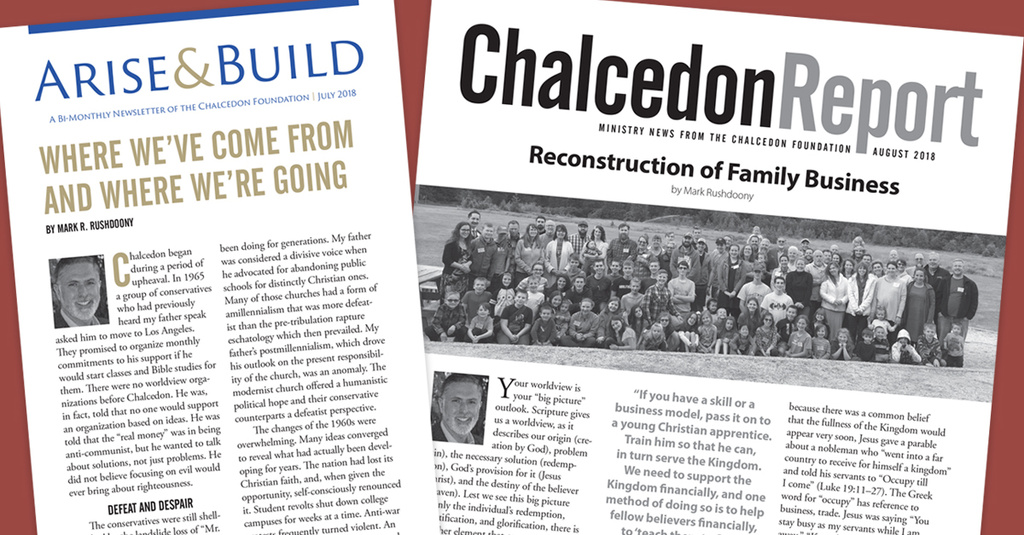
Chalcedon Publication Changes
Changes are part of life, and we know that if we refuse to accept them we find ourselves increasingly “out of touch.” When my grandparents arrived at Ellis Island in 1915 they had a distinct advantage in that they were already fluent in English. Those few who arrived as adults and never learned the language became dependent on others because they did not adapt to the change.

- Mark R. Rushdoony
Changes are part of life, and we know that if we refuse to accept
them we find ourselves increasingly “out of touch.” When my grandparents
arrived at Ellis Island in 1915 they had a distinct advantage in that
they were already fluent in English. Those few who arrived as adults and
never learned the language became dependent on others because they did
not adapt to the change.
It is now time for Chalcedon to adapt to changing circumstances and economics. Since our inception in 1965 our principal means of communication has been publishing, both mailers and books. The technology of books has made it easier and cheaper to produce new titles, and short runs of older titles are now economically feasible. As a result, titles that went out of print in the 1970s and 1980s are once again available. The technology of typesetting made bookmaking a very labor-intensive undertaking. Mark Twain lost much of his fortune by investing in an automated type-setting machine that ultimately failed. As late as 1980 typesetting was closer to the technology of Gutenberg’s day than the computer-based systems now available.
But while book-making costs have come down, mailing costs have risen substantially. Our Faith for All of Life magazine costs us over $9,000 per issue, a substantial amount for a magazine format which, by its nature, is meant to be disposable. Moreover, what goes into a magazine can be put online on our website.
We have been developing our website. When we started the website years ago I was encouraged to do so on the promise that the cost was “virtually nothing.” That was certainly a misleading sales-pitch if ever there was one! Posting a single article may cost little, but the platform on which to do so has a very real cost. Chalcedon’s old website had become obsolete in less than a decade; the cost of fixing small issues became prohibitive. A year ago we launched an all new www.chalcedon.edu. There is no other archive like it. Eventually we want all of our past publications (to 1965) put in the “resources” section. The software design involved a substantial investment, but there is no other archive of Christian Reconstructionist material like it. We need to shift more of our output to our website and other on-line formats.
The magazine format also had very real limitations. Due to the lead-time necessary for publishing, it was not a format conducive to current topics and commentary.
Our new bi-monthly mailer, Arise and Build, will alternate with the Chalcedon Report. The latter will continue as a means of ministry update and related items of work in the Kingdom we find of interest.
Does this format have limitations? Yes, obviously, but so does Chalcedon’s budget. We have always said that “your giving establishes the limits of our work, humanly speaking.” We feel it is time to begin limiting our mailing cost while increasing other areas of communication. This format allows us to share one or two short essays with each issue.
For many years Chalcedon produced the Journal of Christian Reconstruction, which contained scholarly articles that would be of long-term benefit to those who wished to further the work of the Kingdom. We are in the process of reviving that publication, as Martin Selbrede relates in a separate article. In addition, we can publish articles on chalcedon.edu. Did you realize that sharing Chalcedon articles on social media greatly expands our outreach?
It is hard to say goodbye to Faith for All of Life, but Chalcedon has used several formats over the years. The first, in 1965 was merely called Newsletter with a sequential number. It was mimeographed and stapled. In 1969 the name Chalcedon Report was added.
The Report was professionally typeset and printed beginning in 1973. Over the next fifteen years other features (such as Book Notices, Position Papers, Dominion Work, Our Man in Washington, etc.) were printed separately and all inserted loose in a number 10 envelope. It was not an optimal presentation, so in 1987 we began publishing the Chalcedon Report in a magazine format. In 1998 we added a glossy color cover. In 2005 we changed the name of the magazine to Faith for All of Life and alternated bi-monthly with the Chalcedon Report which became more of what its name implies, a ministry update.
And now we introduce yet another change. With every change we find reason for some level of dissatisfaction. Some will lament the end of the magazine because they will not go online to read. Others think the entire ministry should go digital. One reason we cannot do that is a high percentage of our readers never go to chalcedon.edu. To go fully digital would be to cut off communication.
We can only do what your giving allows. Our costs increase every year, so we must make decisions based on what your giving allows. I wish you could see what a tremendous job Chalcedon’s small staff (5 full-time, 4 part-time) does. We take great care in creating quality books. The multiple proofreadings alone that each book undergoes is a time-consuming process. Jill spends extra hours at home formatting our eBooks, in addition to updating our website and taking orders. Our website requires constant monitoring because of the never-ending attempts to hack it in order to post embarrassing content. I hope you will explore our website. The home page does not reveal the many layers of content. I suggest you click on “Resources” at the top of the page and type in a search of what you are looking for. The left-hand filter menu helps to limit the search. Chalcedon has produced the cutting-edge, definitive work on Christian Reconstruction for fifty-three years and we are working hard to archive all of it. In addition, we seek to communicate in the most effective means possible. This new format is an effort to that end. Please sign-up for our publications, so that we can continue to communicate with you while making the most of the resources at hand.
We very much appreciate your feedback on the new format.

- Mark R. Rushdoony
Mark R. Rushdoony graduated from Los Angeles Baptist College (now The Master’s College) with a B.A. in history in 1975 and was ordained to the ministry in 1995.
He taught junior and senior high classes in history, Bible, civics and economics at a Christian school in Virginia for three years before joining the staff of Chalcedon in 1978. He was the Director of Chalcedon Christian School for 14 years while teaching full time. He also helped tutor all of his children through high school.
In 1998, he became the President of Chalcedon and Ross House Books, and, more recently another publishing arm, Storehouse Press. Chalcedon and its subsidiaries publish many titles plus CDs, mp3s, and an extensive online archive at www.chalcedon.edu. His biography of his father will be published later this year (2024).
He has written scores of articles for Chalcedon’s publications, both the Chalcedon Report and Faith for all of Life. He was a contributing author to The Great Christian Revolution (1991). He has spoken at numerous conferences and churches in the U.S. and abroad.
Mark Rushdoony has lived in Vallecito, California, since 1978. His wife, Darlene, and he have been married since 1976. He has four married children and nine grandchildren.
